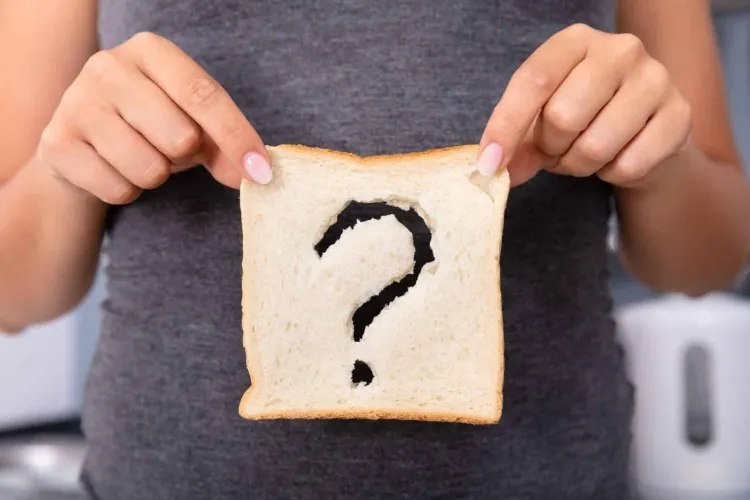What are the symptoms of gluten intolerance? How can I test myself to find out if I’m lactose or gluten intolerant? Which foods to tolerated or avoid?
Gluten is everywhere via wheat, rye, barley, in our favorite pasta and cookies. Even spelt, considered healthier, contains gluten, to the great detriment of those who follow balanced diets. To find out if you have gluten intolerance, you must first detect the symptoms of celiac disease, which manifests itself in considerable digestive discomfort. Let’s take a close look at a gluten-intolerant person and how they feel.
What Is Gluten Intolerance?
Our antagonist likes to snack on salty sticks between meals, while working on his computer. He prefers to dip the crusty baguette in gluten-packed soy sauce instead of gluten-free ketchup. His favorite dessert is the chocolate muffin, which can be replaced by a gluten-free coconut flour muffin. So we have the classic example of a person who only eats unhealthy foods. He ignores the digestive discomfort that follows meals: bloating, abdominal pain, diarrhea and constipation one after the other.
Gluten intolerance, or gluten sensitivity, is a condition in which the body reacts poorly to the consumption of gluten, a protein found in wheat, rye and barley grains. To find out if you are sensitive to gluten or if you have celiac disease, you have to do a test. It’s very important to know what exactly it is, because these are different conditions. Celiac disease is a serious autoimmune disease that can damage a person’s digestive system, and it’s possible to confuse gluten intolerance with a wheat allergy. The latter is no less dangerous, as it can interfere with breathing or cause loss of consciousness, which is not typical for the other two.
What Symptoms Are Associated with Gluten Intolerance?
Let’s take a look at our antagonist’s menu. For years, he’s been banishing white bread, but from time to time, he’s tempted by treats like a pumpkin mille-feuille cake or a strawberry clafoutis or another seasonal fruit (cherry or apricot). It happens that after having a good feast, our character feels tired and experiences headaches. Diarrhea or constipation may also occur.
It is normal for such problems to occur due to many reasons, but when it happens almost every day, you have to do a test.
It’s unfair, but junk food is preferred to healthy food because of its taste. So we overeat without realizing it. The second common symptom is bloating. This is a sign of a stomach full of accumulated gas that makes it hard.
Anyone can experience abdominal pain, but to find out what causes it, you need to take a gluten intolerance test.
Fatigue and nausea are among the symptoms of many illnesses, but when they combine with the previous ones, we must be alarmed.
How Do You Know If You Have Gluten Intolerance?
A test that proves that you cannot tolerate gluten does not exist. Taking a blood sample, which is then tested, can detect the presence of antibodies indicating celiac disease or wheat allergy. If these two are excluded, one must look for the culprit elsewhere and further tests should be carried out on the recommendation of a specialist.
The first thing you can do that can be a game-changer is to reduce or remove gluten from your menu and monitor the progress of symptoms at the same time.
A food diary is the solution that will set the record straight if you record everything you eat over a period of time and your body’s reactions.
How to reduce gluten consumption? While people with celiac disease should exclude gluten from their diet as soon as a doctor diagnoses them, others with gluten intolerance need to slowly reduce its intake, rather than eliminating it immediately. It can help if a person starts by including one gluten-free meal a day before slowly adding more, as cutting it out altogether can be a double-edged sword. Symptoms are strictly individual and consuming small amounts of gluten may not cause any of them.
What Foods Are Prohibited on a Gluten-Free Menu?
Anything cooked with plain flour should be avoided. If common grains are not recommended, are there others to include in the diet without a harmful impact? The good news is that there are 8 that are good for the gut and overall health. Can’t wait to find out? Well, here they are! Well, here they are! Common sorghum, quinoa, teff, buckwheat, millet, brown rice and amaranth.
Remove pasta, bread and pastries, noodles, pancakes, waffles and crepes, non-diet biscuits from your menu. Their alternatives are no less tasty, for example fluffy gluten-free bread.
It is essential to know that celiac disease affects only about 1% of the population and that some estimates place the prevalence of gluten intolerance between 0.5% and 13%.




